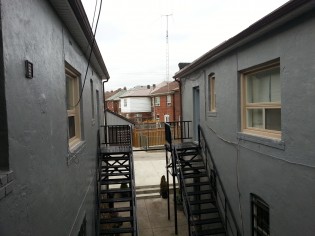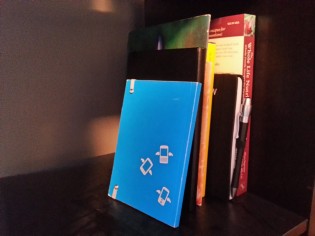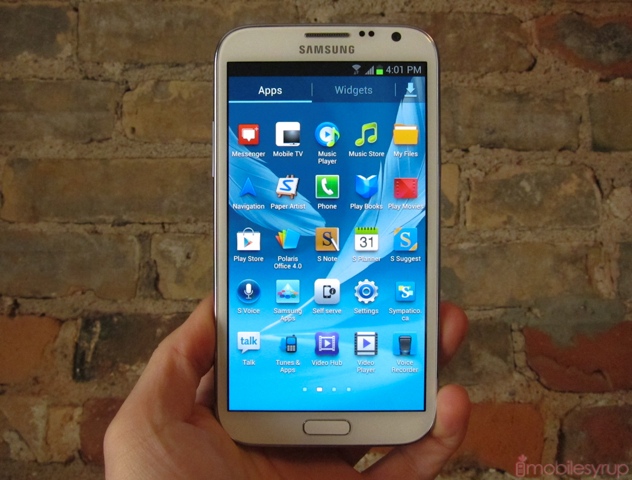
Who would have thought that barely eight months after the Canadian release of the original Galaxy Note we’d be at it again?
The Galaxy Note II embodies the very idea of incremental progress: its screen is bigger, but its body is narrower; its resolution is lower, but its display is clearer, brighter; its processor is more efficient, but its battery is larger. Progress.
Coming so soon after the original Note, the sequel isn’t necessarily aimed at the original fleet of owners. Rather, it is after a whole new demographic, one that has enough time to embrace phones with larger footprints — and higher prices.
The Note II boasts a number of excellent improvements over the original, and over the smaller Galaxy S III. But is it worth your money and, more importantly, the extra space in your pocket? Read on.

Specs
– Android 4.1.1 Jelly Bean with TouchWIZ Nature UX
– 5.5-inch 1280×720 pixel HD Super AMOLED display
– 1.6Ghz quad-core Exynos SoC with Mali-400 GPU
– 2 GB RAM, 16/32GB internal storage, microSD slot
– 8MP back camera / 1.9MP front camera
– 3100 mAh battery (removable)
– 151.1 x 80.5 x 9.4 mm
– 180g
– EDGE/HSPA+ 21Mbps/LTE 75Mbps
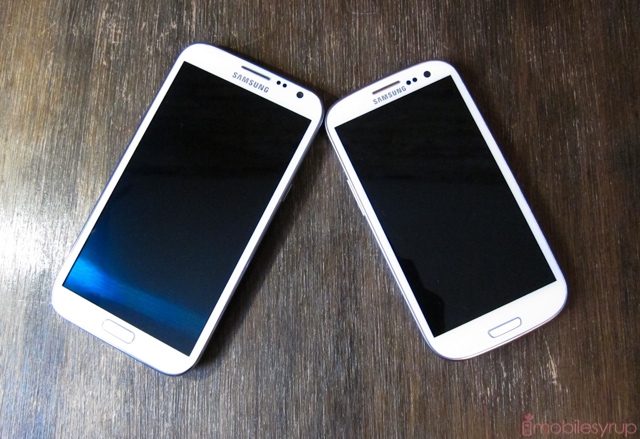
Device & Display
There is no question that the Galaxy Note II body is based almost entirely on the soft curves of its smaller sibling. The Galaxy S III has a striking and divisive design; some users claim its plastic does not feel robust and scratches easily, while others love its ergonomic shape and feather-like weight. Due to its considerable size and heft, the Note II feels like a more premium product than the GS3, but is made of the same HyperGlaze-covered plastic.
Despite its size, it is far more pocketable than the original Note, largely due taller-and-narrower design. Its bezel is also narrower, compensating for the extra space taken by the modestly larger 5.5-inch screen. While this is very much a two-handed device, the Galaxy Note II can be used, with difficulty, in one hand.
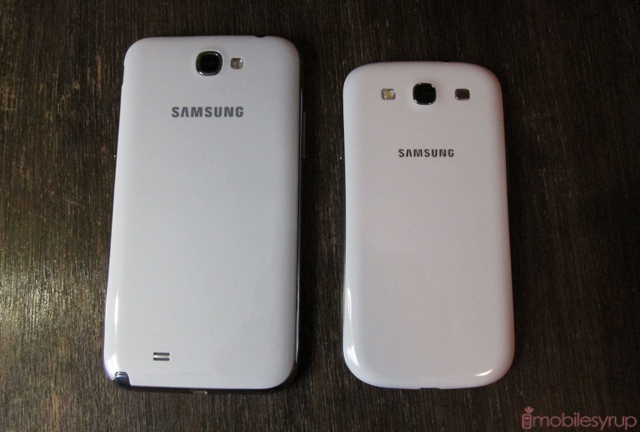
It’s hard to overlook the fact that despite Samsung’s success in the smartphone market, it puts its products at a marketing disadvantage by using more inexpensive materials than its competitors. It doesn’t help that those competitors have drastically increased the amount of metal, glass and high-end polycarbonate in their phones. Motorola and LG in particular are creating gorgeous, well-designed Android phones with high quality materials at entry prices lower than Samsung’s flagships. Then again, neither company earned $24 billion from their mobile phone divisions in the last quarter, so plastic is clearly not impeding Samsung’s ability to sell phones.
The placement of buttons is where you’d expect them to be on a Samsung device: power button on the upper right side, single volume rocker on the upper left. The back cover feels sturdy, but comes off easily. Inside is a 3100mAh battery, larger by a quarter than the original Note and just under the standard set by the Droid RAZR MAXX. Being removable, one can order replacement cells for the device, making the Note II somewhat more versatile than the majority of recent smartphones.
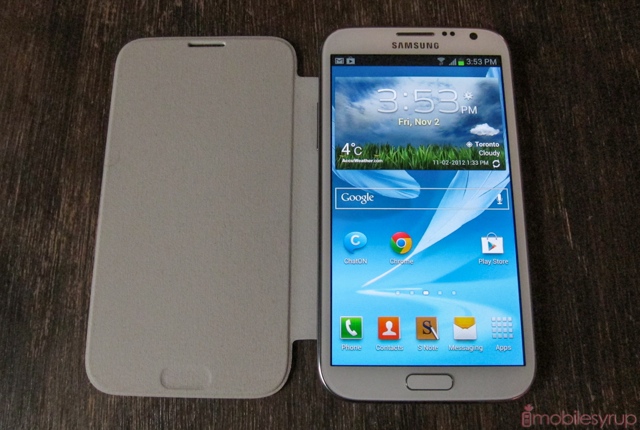
Then again, the Galaxy Note II is no ordinary smartphone. While comfortable to hold, one is forced to make concessions to fit it into his or her life. The company takes care to ensure it is usable with one hand – a custom keyboard, dialer and lock screen are included – but most UI elements are just displayed larger than the average phone screen. Whether this is a positive or negative attribute depends on the person; as with the original Note, I do not recommend going into this purchase without first using the phone in store.
Despite the lower resolution, the Note II display is significantly sharper than the original. Samsung has managed to do away with the PenTile display of the original – and the Galaxy S III – and the Note II is better for it. Because the underlying technology is still AMOLED, colours are rich and vivid while black levels are perfect. Whites still retain a slightly blue tone, but are not as obviously discolored as earlier models.
Mainly, due to the new subpixel arrangement, text is much sharper and more pleasing to the eye. Viewing angles, too, are improved over the original Note. The Note II looks fantastic, and has by far the best Super AMOLED panel available on a phone today.
Then there’s the fact that Samsung added a Wacom digitizer to the screen to interact with the S Pen. The included stylus is more versatile than a regular capacitive pen: it is pressure sensitive, and allows for far more nuanced application over a finger.
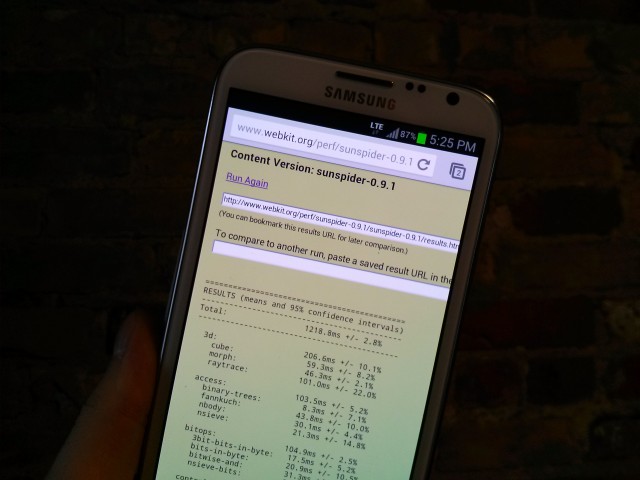
Performance
The Galaxy Note II is one of Canada’s first quad-core devices to ship with LTE support. Until now, Samsung hadn’t been able to ship its Exynos 4 SoC with a LTE baseband chip, relying instead on Qualcomm’s Snapdragon S4 solution to do the trick.
It’s possible that the Exynos 4412 inside the Galaxy S III, built on Samsung’s 32nm process, was too power-intensive to use with the smaller device’s 2100mAh battery, but it’s more likely that Qualcomm’s solution was cheaper at the time. Paired with a 3100mAh cell, the Note II does not suffer from poor battery life despite the 1.6Ghz CPU, higher-clocked Mali-400 GPU and a LTE baseband. And the phone flies.
Going head-to-head with Qualcomm’s quad-core Snapdragon S4 Pro solution, the Exynos-powered Note II is one of the fastest mobile devices I’ve ever used. I regularly achieved benchmark scores 20-30% higher than the dual-core Galaxy S III in CPU tests, and 30-50% higher in GPU tests. Combined with the “buttery” speed inherent to Android 4.1.1 Jelly Bean, the Note II is truly able to be a computing replacement.
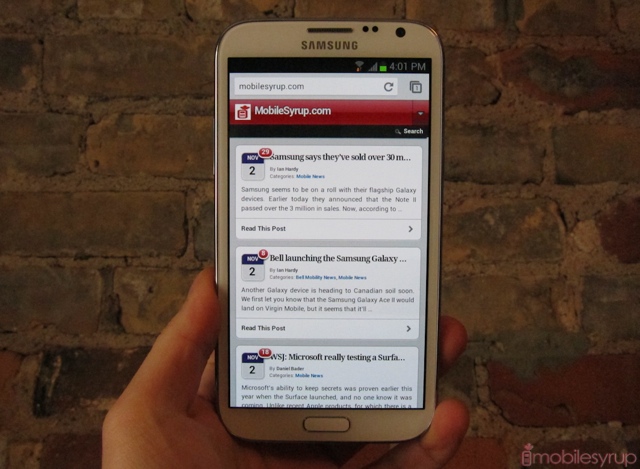
Samsung has maintained the “picture-in-picture” mode from the Galaxy S III, allowing you to watch video while inside other apps. It didn’t work so well on the smaller display, but two things have made the feature worth using now: the physically larger display, and the ability to easily resize the viewing window. Even when watching 1080p clips the Note II never stuttered or showed any hint of slowdown.
Canadian carriers have yet to push out an important update to allow single-screen multitasking. This feature was pushed to international Note II’s in an update shortly after release, bringing the ability to use two apps side-by-side in landscape mode, with no appreciable lag. The feature debuted on the Note 10.1 tablet but from what I’ve seen, the Note II implementation is much better.
Like the screen, the Note II takes what made the original so fantastic and PC-like and improve upon it. Few high-end Android smartphones these days are slow; the Note II is just exceptionally fast.
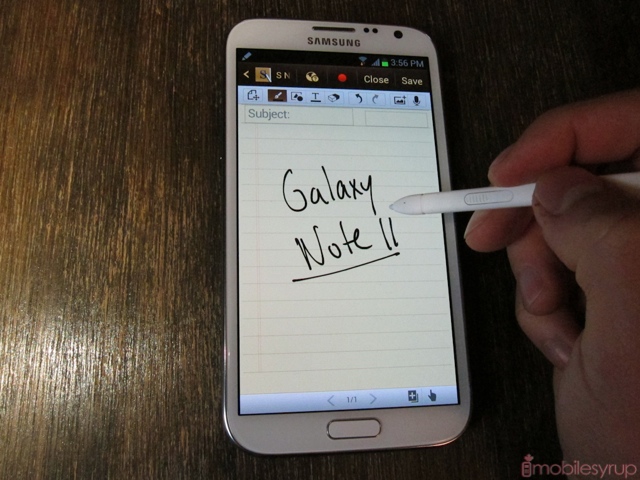
S Pen
The new S Pen, built into a small slit on the bottom right of the phone, is improved over the original. It is slightly wider and therefore more comfortable to hold. It also brings far improved sensitivity, making the Note II the closest to a notepad replacement I’ve used to date.
Air View allows you to hover the S Pen above the screen, adding a third layer of interactivity to the mix. A small dot, like a mouse cursor, appears on the display, letting you preview images inside photo albums or find the right spot in a video without leaving your spot.
As always, the S Pen’s greatest virtue is in annotation. Remove the stylus from its slot and a “creative” home screen appears, begging you to create a diary entry or travel log. Simply, the updated S Note app is fantastic, combining a painter’s palette and a sketcher’s kit in one place. The interface is slightly clunky – it often takes too many steps to find what you’re looking for – but no other OEM is as dedicated to the creative crowd as Samsung. Indeed, that’s how they’re marketing the phone.
Simply, the S Pen is fun. I’m not a huge note-taker on a good day, but being able to take a screenshot and write a note to my friends or post it on Facebook is a huge draw for me, even if I seldom take advantage of it. The Note II comes at a premium, but even those who will use the S Pen once or twice a week, the added c0st is worth it.
Camera
The Galaxy Note II incorporates the same excellent 8MP camera as the Galaxy S III. Simply, it takes some of the best photos found on a mobile device.
From stable 1080p video to vivid, high-fidelity daytime shots, the Galaxy Note II is a great portable camera. It’s also a superior viewfinder, as the large screen means you can more easily frame your photos.
The quad-core processor and Jelly Bean software give the shutter an added speed boost, making an almost instant shot even quicker. While I yearned for a physical shutter button on the slightly-unwieldy body, Samsung’s camera UI is one of the best in the game.
There are some improvements to the camera experience over the Galaxy S III: Best Face is Samsung’s implementation of a blink suppressor. It will begin caching photos before the shutter is pressed, and if one or more subjects close their eyes, you can “rewind” a few frames to find one in which they’re open. Best Photo takes eight successive shots and asks you to pick your favourite; it’s almost like a game. Then there are the requisite HDR and Panorama modes, as well as Samsung’s highly-marketed Share Shot, which connect to other “S Devices” over WiFi direct to synchronize your recent photos with other Samsung owners.
Then there’s Low Light mode which, unlike solutions from other companies, actually seems to improve the state of low light photography. To the left is the photo taken with the setting turned on. You can see more noise, yes, but also far more of the actual subject matter.
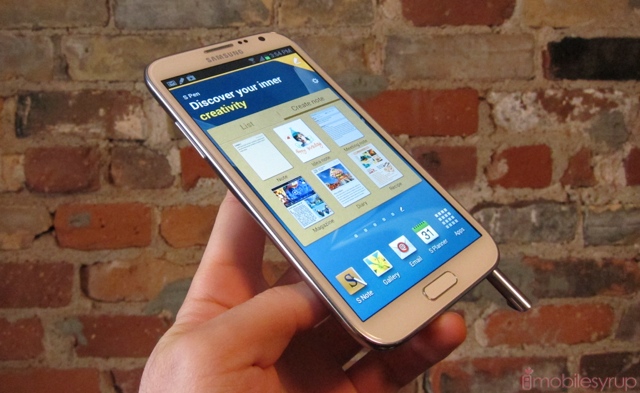
Software
The Galaxy Note II is the first non-Nexus device to ship in Canada with Android 4.1 Jelly Bean. While I noticed few performance improvements over the Galaxy S III running Ice Cream Sandwich, the experience was consistently fast and fluid.
The two main benefits to using Jelly Bean are Google Now – the company’s Siri competitor – and expandable notifications. The former is accessed, rather unfortunately, by holding down the home button and tapping the too-small “G” next to the “End all tasks” and “App Manager” shortcuts. In other words, Samsung is burying Google Now in favor of its own S Voice solution. To put it mildly, S Voice is terrible, especially when compared to the passive intelligence of Google Now, recently updated to provide even more pertinent information. By default, Samsung uses a double-tap of the physical home button to activate S Voice; I’d love to be able to do the same for Google Now, but I imagine it’s impossible without rooting the phone.
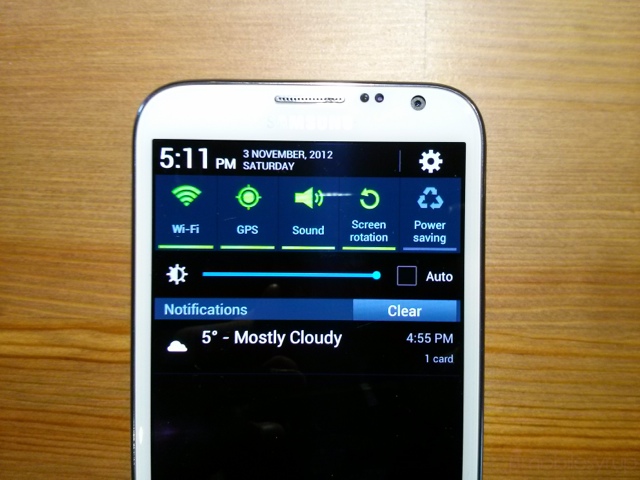
Expandable notifications are another fantastic inclusion in Jelly Bean: the ability to preview your email or see which apps have updates available in the Play Store are more than merely “nice to have.” They fundamentally change the way you interact with your Android phone.
Most Android apps work quite well on the larger screen of the Note II. There were times I wished that the device would display the tablet version of an app, but for the most part I never felt as if UI elements were too big. Reading books on the Note II is a fantastic experience, as is browsing on Chrome or watching HD movies. While the screen is too small to replace your 7- or 10-inch tablet for productivity purposes, consuming content on the Note II is a joy. With a microSD card slot, the process of transferring music and movies to the phone is a cinch.

Battery Life & Network Speed
You likely already know the answer to this question, but how is the battery on the Note II? In a word: fantastic. Even when connected to LTE I was able to get nearly two days’ usage out of the battery. If you’re willing to spend $50 on a replacement battery, the phone can last even longer.
With heavy use – several email accounts, constant Twitter and Facebook notifications, several photos and videos, some YouTube streaming and the occasional phone call – the Note II lasted 16 hours on a single charge. Not quite the beastly lifespan of the Motorola RAZR HD LTE, but close.
By lowering the brightness, turning off Bluetooth and WiFi when not in use, and disabling LTE, the Galaxy Note II managed two days of moderate use.

The phone managed just under 10 hours of video playback in our battery rundown tests at 50% brightness and LTE turned on. With LTE turned off, the device eked out an extra hour and 45 minutes, bringing it up to nearly 12 hours.
Of course, the Galaxy Note II is LTE-connected, and available from Rogers, TELUS and Bell. We tested the phone on Rogers and Bell and obtained speeds of between 20Mbps and 50Mbps down and 6-30Mbps up depending on the network and the time of day. In other words, the phone is impressively fast.
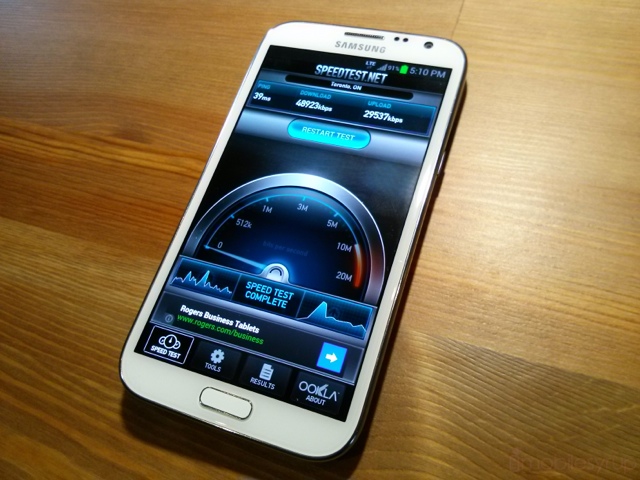
Holding the phone to your ear may seem a bit absurd given its size, but if you decide to use the Note II as a phone you’ll be greeted with excellent reception regardless of network. The back speaker, like most mobile devices, is underpowered but sufficient to fill a room with thin sound.
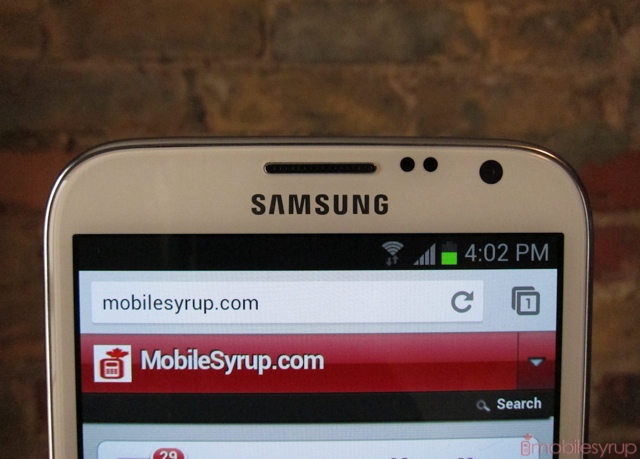
Conclusions
Samsung recently boasted that it has already sold over three million Galaxy Note II devices. It’s not quite the monumental 30 million number of the Galaxy S III, but it’s on pace to outsell the 10 million number of the original in short order.
As an evolution over the original, the Note II is better in every way. It’s not for everyone, but one can’t penalize a purposefully large device for being cumbersome. It may fit in the palm of LeBron James’ hand, but for the rest of us regular-sized people, it takes a short adoption period before all other phones feel laughably small.
The Note II is screaming fast, extremely versatile, well-built despite its plastic body, and runs considerably newer Android software than the majority of recently-released devices. Whether it’s enough of an upgrade over the original to warrant breaking a three-year contract after eight months depends on your needs. To the uninitiated, it’s easy to imagine transitioning from the 4.8-inch Galaxy S III to the 5.5-inch Note II. Ultimately, it comes down to price, size and, well, the S Pen.
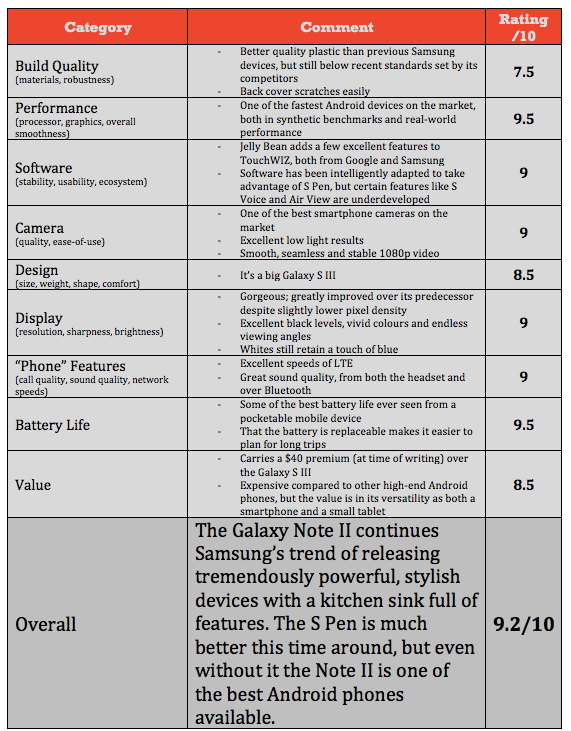
MobileSyrup may earn a commission from purchases made via our links, which helps fund the journalism we provide free on our website. These links do not influence our editorial content. Support us here.

